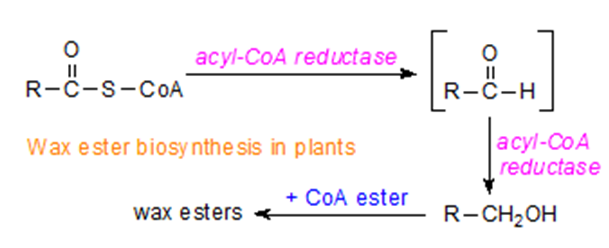
Wax esters are produced by combining one fatty alcohol molecule with one fatty acid. Organic acids typically have a carboxyl (-COOH) group. Alcohols have a hydroxyl (-OH) group. Organic acids and Alcohols join to form esters. In wax esters, the hydroxyl group of the fatty alcohol joins the carboxyl group of the fatty acid to form ester bonds. There are diverse types of wax esters, with the primary differences being between saturated and unsaturated types. Saturated wax esters possess a higher melting point and are likely to be solid at room temperature. Compared with saturated wax esters, unsaturated wax esters have a lower melting point and are more apt to be liquid at room temperature. Both fatty acids and fatty alcohols may be of different carbon chain length. In addition, there are numerous different possible combinations of fatty acids and fatty alcohols and each combination will have a unique group of properties in terms of phase transition and steric orientation.
Fatty acids and fatty alcohols in naturally occurring wax esters differ in the chain lengths. The fatty acids in wax esters derived from plants usually range from C12-C24, and the alcohols in plant waxes are likely to be very long, usually C24-C34. Wax esters are typically found as a part of the cuticle of leaves, shellfish and arthropods, preventing loss of water. Plants such as beeswax and jojoba store large quantities of wax esters. Marine organisms like pelagic invertebrates, dinoflagellates and fishes store low-density wax esters using their swim bladders or other tissues to provide buoyancy.
Lipases and carboxyl esterases that hydrolyze triglycerides have shown enzymatic activity towards wax esters. Kinetic data indicate that EPA and DHA provided as wax esters reaches a maximal concentration at nearly 20h post-consumption, and may suggest delayed absorption of the fatty acids.
Currently, a reliable and reproducible method using highly sensitive LC-MS/MS platform for the identification and quantification of wax esters in different sample types has been established by the scientists at Creative Proteomics, which can satisfy the needs of academic and industrial study in your lab.
Platform
- LC-MS/MS
Summary
Identification and quantification of wax esters.
Sample Requirement
- Normal Volume: 200 uL plasma, 20 mg tissue, 1e7 cells
- Minimal Volume: 50 uL, 5 mg tissue, 6e6 cells
Report
- A full report including all raw data, MS/MS instrument parameters and step-by-step calculations will be provided (Excel and PDF formats).
- Analytes are reported as uM, with CV's generally ~10%.
Ordering Procedure:

*If your organization requires signing of a confidentiality agreement, please contact us by email.
Staffed by experienced biological scientists, Creative Proteomics can provide a wide range of services ranging from the sample preparation to the lipid extraction, characterization, identification and quantification. We promise accurate and reliable analysis, in shorter duration of time! You are welcome to discuss your project with us.





